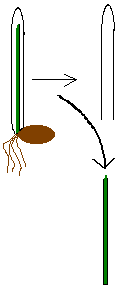
Back Koleoptil BS Coleòptil Catalan Koleoptile German Coleoptile Spanish ساقهپوش FA Coléoptile French Koleoptil Hungarian 子葉鞘 Japanese Diegamakštė LT Coleoptyl Dutch


Coleoptile is the pointed protective sheath covering the emerging shoot in monocotyledons such as grasses in which few leaf primordia and shoot apex of monocot embryo remain enclosed. The coleoptile protects the first leaf as well as the growing stem in seedlings and eventually, allows the first leaf to emerge.[1] Coleoptiles have two vascular bundles, one on either side. Unlike the flag leaves rolled up within, the pre-emergent coleoptile does not accumulate significant protochlorophyll or carotenoids, and so it is generally very pale. Some preemergent coleoptiles do, however, accumulate purple anthocyanin pigments.
Coleoptiles consist of very similar cells that are all specialised to fast stretch growth. They do not divide, but increase in size as they accumulate more water. Coleoptiles also have water vessels (frequently two) along the axis to provide a water supply.
When a coleoptile reaches the surface, it stops growing and the flag leaves penetrate its top, continuing to grow along. The wheat coleoptile is most developed in the third day of the germination (if in the darkness).
- ^ "Coleoptiles - an overview | ScienceDirect Topics". www.sciencedirect.com. Retrieved 2021-05-04.